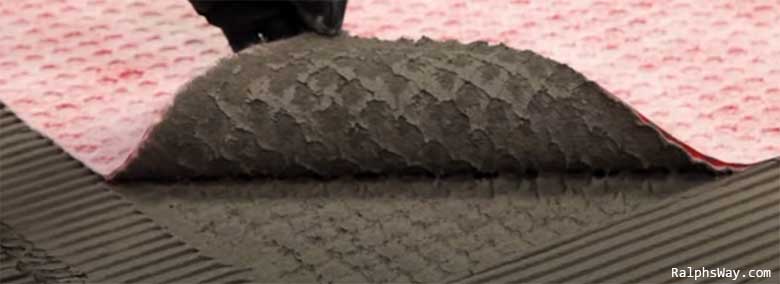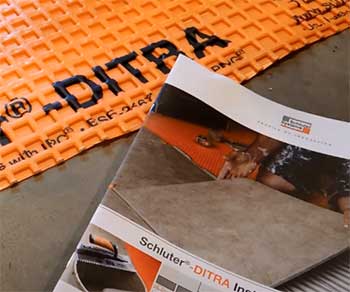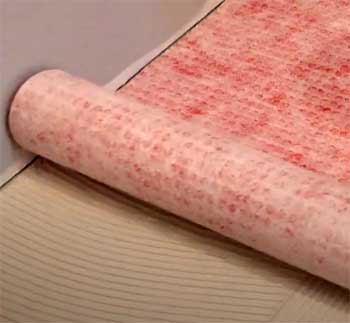There are tons of different uncoupling membrane options available on the market, and people often seem confused between two popular options, RedGard uncoupling mat vs. Ditra.
Uncoupling membranes are well-known for significantly increasing the durability of a tiled floor. Simply put, the membrane works as a break between the floor and the tiles. This way, both surfaces get to move independently.
In this, I’ll compare RedGard and Ditra uncoupling membrane to help you get rid of the confusion here. Keep reading as I discuss different factors.
A Quick Comparison Table
Before we head into the detailed discussion, I have compiled a quick comparison table here. It’ll give you a primary idea about the differences between the RedGard uncoupling membrane and Ditra.
Also, if you are in a hurry, you can get the gist of the whole comparison from here.
| Specification | RedGard uncoupling mat | Ditra uncoupling membrane |
| Material | Liquid-applied elastomeric waterproofing material | Polyethylene |
| Ease of installation | Easy | Complicated than RedGard |
| Thickness | 1/4″ | 1/8” |
| Crack Isolation | Yes | No |
| Subfloor surface compatibility | Good | Better |
| Longevity | Good | Excellent |
| Cost | Cheaper | Expensive that RedGard |
Key Differences Between RedGard Uncoupling Mat And Ditra

After the comparison table, let’s consider the detailed differences from different aspects. Some significant differences are coming up, and in the end, you should be able to decide which one would be a better-suited choice for you.
- Material
The first significant difference we see here is the materials used for both membranes. As one is a membrane and the other one is a mat, it was pretty much expected here.
While RedGard uncoupling membrane is made of Liquid-applied elastomeric waterproofing material, the Ditra uncoupling membrane is made of polyethylene.
While the elastomeric material of RedGard turns into a monolith membrane to work, the Ditra membrane has a grid structure with anchoring fleece of polyethylene. However, both the RedGard uncoupling mat and the Ditra uncoupling membrane work flawlessly despite the material difference.
- Ease of Installation

To get the best out of the uncoupling membrane/ mat, you must ensure the installation is perfect.
In that Regard, Ditra seems to have the upper hand over RedGard. Let me tell you why.
Without proper installation, the membrane might not work collectively with the mortar, causing stress to the whole tiling structure.
Ditra has an anchoring fleece that provides strong adhesion and better uncoupling performance.
But more importantly, you get a more straightforward installation process just with the help of some primary tools.
- Thickness
If you have done your share of research, you might have already noticed that uncoupling membrane/ mats come in a different thickness like 5/16”, 1/8”, or 1/4”. Now each of these sizes, thin and thick, has its advantages and disadvantages.
The RedGard uncoupling membrane mat is 1/4” thick, while the Ditra uncoupling membrane is only 1/8” thick. While thicker membrane/ mats can help durability, they are not great at eliminating the moisture inside.
So, the 1/8” thickness of Ditra gets the upper hand with less humidity and reduces the thickness of the overall tile structure.
- Crack Isolation
Crack isolation is an essential feature since it can play a role in protecting your tiles from future cracks. When there are cracks in the substrate you are installing the tiles on, your uncoupling membrane must have some crack isolation.
The crack isolation will isolate these cracks on the substrate and prevent them from coming up through the tiles. While the RedGard uncoupling mat is known to be a crack isolator, there is no such thing advertised from Ditra.
So, RedGard seems to get the win in this segment.
- Subfloor Surface Compatibility
While there are many factors to discuss, this compatibility is the one we often forget to consider. You have to understand that not all substrates are compatible with all types of uncoupling mats or membranes.
So, before making the purchase, you have to ensure sure whether RedGard or Ditra works with your particular substrate.
Both Ditra and Regard offer broad compatibility, so it’s hard to pinpoint any difference here. However, it’s a little heavier on the Ditra’s side with installation over gypsum, plywood/ OSB, heated floors, concrete, etc.
On the other hand, the RedGard uncoupling membrane works excellent with various substrates, including challenging ones like wooden floors and green concrete.
- Longevity

Uncoupling membrane/ mat isn’t something you change every day.
So, you have to make sure that whatever you are installing lasts you long enough and provides you with the necessary durability.
After all, the structural integrity of your tiles is on the line here.
While the thicker frame of RedGard has an issue with moisture, it’s excellent in terms of longevity for years to come.
On the other hand, Ditra has done a better job at keeping the moisture out, but that might compromise the longevity of the membrane.
- Cost
At the very end, I’ll talk about the price for a moment. Both RedGard and Ditra come in different sizes and price points, and Ditra seems to cost a few bucks more than the RedGard option.
Though the price gap isn’t significant enough to affect a purchase decision, you should know it beforehand.
Overview of RedGard Uncoupling Mat
RedGard uncoupling mat is a thin, rolled uncoupling membrane reinforced with fiberglass mesh. It is 1/8” thick and made from pliable PVC that provides crack isolation up to 3/8”.
RedGard is naturally waterproof. When properly installed, it forms a waterproofing barrier over your subfloor. The material allows for movement and flexibility while preventing moisture penetration.
To install RedGard, you first prep and level your subfloor. Then, roll out the RedGard mat and cut it to fit your installation area. The lightweight material cuts easily with a utility knife.
RedGard mat attaches directly to the subfloor with flooring screws or construction adhesive.
Finally, you install your tile directly over the RedGard per manufacturer’s instructions.
RedGard can be used over plywood, concrete backer board, concrete, and many other subfloors. It isolates cracks up to 3/8” to prevent them from transmitting through tile. The product is mold and mildew resistant.
The benefits of using RedGard uncoupling mat include:
- Cost effective compared to other uncoupling membranes
- Naturally waterproof, seals around fasteners
- Thin profile adds minimal height
- Lightweight and easy to cut
- Simple installation process
- Provides reliable crack isolation
Potential drawbacks of RedGard are that seams and corners require special treatment with RedGard liquid waterproofing to ensure full waterproofing. The seams can be tricky for novice DIYers.
Overview of Ditra Uncoupling Membrane

Ditra is an uncoupling membrane made by Schluter Systems. It is designed specifically for ceramic and stone tile installations.
Like RedGard, Ditra mat is 1/8” thick. However, Ditra is made from polyethylene with a grid structure design. It is flexible and durable.
The open-rib structure on the underside of Ditra provides space for excess mortar and moisture to dissipate. The topside of Ditra has square cavities to provide mortar contact with the tile.
To install Ditra, you first prep and level your subfloor. Ditra is embedded in thin-set mortar and installed over the subfloor. Seams are sealed using Ditra tape. Tile is then installed over Ditra using appropriate mortar and installation techniques.
Ditra can be used over plywood, concrete backer board, radiant heating systems, concrete floors, and post-tensioned concrete slabs. It provides reliable crack isolation and uncoupling to prevent subfloor cracks from transmitting through tile.
Benefits of Ditra uncoupling membrane:
- Specifically designed for tile installations
- Provides uncoupling and waterproofing in one step
- Allows for thin-set installation techniques
- Ridged design allows mortar to grip tile securely
- Accommodates movement and expansion
Drawbacks of Ditra are mainly the higher cost compared to other membranes and the more intensive installation process. The seams must be properly sealed, and tile must be installed with specific mortar and techniques to work correctly with the Ditra mat.
Which Uncoupling Mat Is A Better Choice?
Considering the different aspects of the RedGard uncoupling membrane and Ditra uncoupling membrane, there are some significant differences between these two. While most differences are mixed bags, it’s tough to pick an overall winner here.
So, depending on your priority and need, puck the one that suits your tiles installation, and you should be good to go.
Frequently Asked Questions (FAQs)
Yes, you can easily use RedGard as an uncoupling membrane. Not only does it works as an uncoupling membrane, but it also does a great job of protecting your tile job even by pairing up with challenging materials like green concrete and wood-framed floors.
The answer to this question is a bit tricky since different peoples have their theory of whether it’ll work or not. If you ask me, it should work fine as the manufacturer advertises itself for waterproofing and crack isolation. Just get a suitable substrate, use two layers of Regard, and you should be good to go.
Yes, you can use Regard over Schluter membrane. But that installation will neither have any positive nor any adverse effect. So, using RedGard over the Schluter membrane is pretty much pointless.
Every uncoupling membrane on the market is entirely waterproof. Apart from being waterproof, it allows the substrate and tiles to move freely, making uncoupling membrane a better choice than cement boards.
Final Thought
Here we are at the end of our article. I hope my article will help you decide between RedGard uncoupling mat vs. Ditra. Uncoupling membrane is still relatively uncommon, so it’s okay to get confused here.
But if you can bear the cost of an uncoupling membrane, it will be worth every single penny.
Especially if you are planning to use expensive tiles and ensure they don’t crack, uncoupling membrane can be a significant part of your tiles set up.

This seems like an AI-generated article. Or if not AI generated, then it’s written by someone who has confused different products. Which I can’t blame the writer for, but it’s unfortunate as this is the first article that pops up when you search for a comparison of the two products, so it’s worrisome that a lot of people might be reading the wrong info.
This article says it compares the Redgard uncoupling “mat” to the Ditra membrane, but much of the info that it discusses for the Redgard “mat” isn’t for their mat, but rather their roll-on, liquid-applied membrane.
To be clear: Redgard makes two products: A roll-on waterproofing membrane that can also act as an uncoupling membrane (this is what most people refer to when talking about ‘Redgard’), but also make an uncoupling “mat”, very similar to Ditra. Like Ditra, it’s thinset-applied, fiber-reinforced, and has a grid pattern (all of which this article got wrong). And this article mentions that Redgard mat is fastened down with flooring screws or construction adhesive, which is just plain wrong. See the technical data sheet for the Redgard mat and you’ll see that it’s applied the same way as Ditra: Both Redgard Mat and Ditra are thinset-applied to the floor, with additional thinset applied on top to adhere the tile. They’re very similar, though I prefer the Redgard mat as it allows you to use modified thinset (whereas Ditra requires unmodified thinset for adhering to the substrate). The Redgard roll/brush-on membrane is a completely different product.